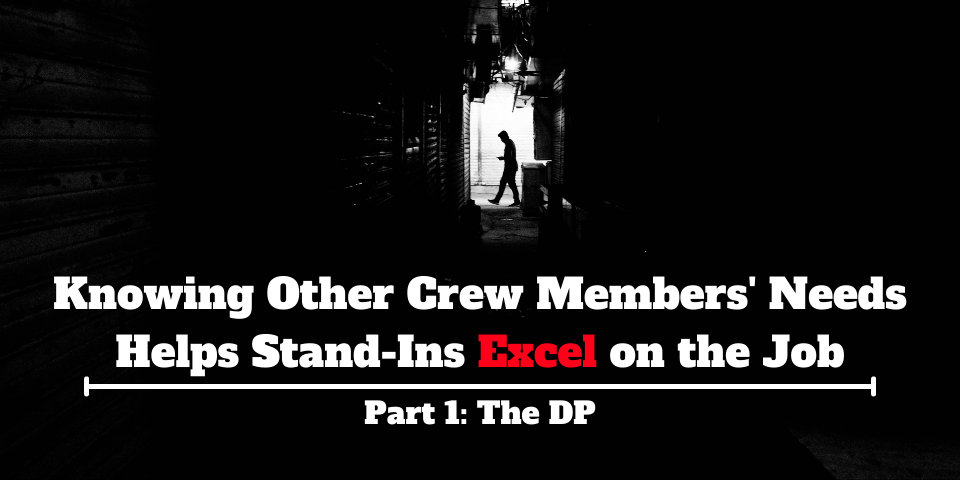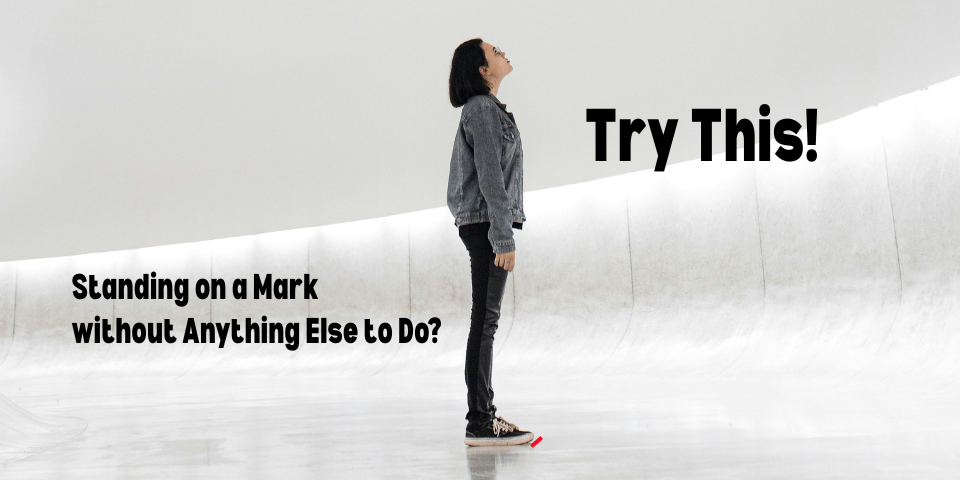This is Part 1 of a multipost series on Stand-In Central.
— The Editor
When you are standing in on a TV or film production, you might be coming to the job completely unaware of what’s needed of you. (That’s why there’s Stand-In Central, as well as its handy ebook The Stand-In Handbook!)
That feeling of being completely unaware of what’s needed of you as a stand-in is completely normal!
Knowledge of what’s required of stand-ins when working on a TV or film set is not common knowledge. One might think your job is “just looking like the movie star and being their buddy.” Not really at all!
Stand-in work has a range of requirements, depending on the specific production. Some stand-in jobs will require relatively little of stand-ins, just having them stand on one mark while they’re lit. Other stand-in jobs will be the opposite, with the stand-ins recreating the exact movements of their actor in a scene, at the same pace, even saying the lines. Some stand-in jobs might seem like all fun and games. Other stand-in jobs might seem super serious, with stand-ins fired left and right!
If you’re interested in more than just the “glamor” of being on a TV or film set, then you’re likely a stand-in who’s interested in some way or another at excelling at your job. You might want a few days of work rather than just one day. You might want a long-term stand-in job. You might want to build a reputation among crew as a stand-in on whom they can rely to do their jobs, so that you might end up with more long-term jobs in the future.
Or maybe you just take pride in your work and you want to be the best you can be when you’re standing in?
Why Are You There?
Well, in order to really excel at the job of the TV/film stand-in, it can come down to understanding not just why you’re there, but also what the other crew members need, and how you can help them do their jobs. That comes with learning about TV and film sets and the different jobs on those sets. Without that knowledge, you can’t know how you can help them.
In this multipost series, we’ll cover what some crew members need from stand-ins. If you can zone into these needs, and anticipate them, as a stand-in you will start to seem as if you are “reading their minds.” When you’re on the ready for when other crew specifically need you, they won’t help but be impressed with your ability to help them out in their work the moment they need you.
Crew Member: The DP (Director of Photography) (aka Cinematographer)
The DP is one of the most important crew members on a set. This person is generally responsible for the, well, direction of the photography. Camera framing decisions, lightning decisions, and the overall look of a shot often comes down to the decisions of the DP.
Stand-ins help most DPs a lot. Stand-ins are what DPs look at when lights are pointed where actors would otherwise be in a shot.
Stand-ins are also what DPs look at when a shot is rehearsed. Some DPs can be very picky, needing stand-ins with a lot of the same facial and body types as their actors, in order to, say, make sure lighting is just how they want it or there is enough light to cover all of the actor’s actions. Other DPs are just as good at their jobs, only not as picky, able to light a shot using stand-ins who look very different from the actors.
What Do DPs Want?
Stand-ins can really excel at their jobs when they are clued into the interests of DPs. However, each DP is different. Studying the needs of a DP is something that will take some time.
- Does this DP need you not to talk?
- Need you to pay absolute attention?
- Need you to have answers to quizzes about what exact actions an actor did?
- Or does this DP just need you to stand there on your mark?
- Will this DP require lots of rehearsals with stand-ins, or just one?
The more you can answer these types of questions, you will start to understand how you can excel at your job under this DP. Stand-ins are like tools, and any good carpenter is going to want good tools nearby when doing work. When a DP needs the stand-ins, therefore, it’s best to be a good stand-in who is not far away, unable to be found. That solves a major interests of most DPs.
What Else Do DPs Want?
But what are some general ways stand-ins can excel with respect to DP needs?
Understanding that you are there to be lit is one thing to consider.
So, when you are on your mark, you’re not “simply” on your mark. You’re actively listening. You’re tracking the DP in case the DP wants you to turn a certain way, like, right now. You realize that a light being shined is being shined on you, so you understand to pay attention. You’re on the ready with an answer to a question about whether an actor turned clockwise or counterclockwise in a scene, reached or did not reach, sat or remained standing, etc. When you’re standing in, you don’t tune out. You might look still, but you are actively paying attention and guessing what the next request will be.
After a first setup has been completed with the actors, you’ll continue to help the DP by having watched the monitors while the scene was being shot, so you can answer any questions the DP might have about what the actors did in a scene. You’ll maybe take notes about a scene, so you can recall the blocking hours later if need be, in case your memory fails. You’ll be proactive about wearing similar clothes your actor is wearing that day in the scenes, or seeking out such color cover from production before the scene is shot.
Inevitably, you’ll start to think like a DP. And when thinking like a DP, you’ll start to be able to guess ways that DP might need you. And through such anticipation, you’ll also be able to guess more often than not exactly how the DP will need you that day.
What You’ll Find
Unfortunately, many stand-ins aren’t tuned into the needs of crew. They might be standing on a mark, but they are oblivious that lights are being pointed at them, in order to light them. They might just think people are moving lights around. Or they might not realize how talking during a closeup on them may make lighting you difficult.
Given the number of stand-ins there are who aren’t as clued into the work, stand-ins who are clued in jump out. They naturally gain more respect from the crew who gets to work with them. That respect may not come Day One, but over the course of several days or weeks, when these stand-ins, presented with various challenges or situations on a set, know what the crew needs and performs in ways to support those crew members’ needs. A DP and a camera operator may thank these stand-ins as the end of a shoot, because these stand-ins really helped them do their jobs, and as a result, helped them spare energy and save the production money.
What are some things you do to help out DPs on the job? What needs do you see they have that other stand-ins don’t see? Share your insights in the comments below!







Leave A Comment